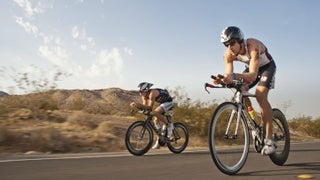Aerobar Setup: Does Lower Always Equal Faster?

Photo: Nils Nilsen

Many athletes assume that the lower the aerobar, the faster the rider. This supposed dogma is wrong. Here’s why.
You still have to generate power
Lowering the aerobars shrinks the angle between the rider’s torso and thigh. Closing this angle too much creates biomechanical and metabolic limitations that can compromise both power and aerodynamics. One of these problems is hip flexor impingement. The hip flexor muscles pull the femur up toward the pelvis, and when the hip angle gets too small, these muscles can no longer pull effectively.
Lowering the bars doesn’t always lower the rider
Lowering the aerobars beyond a certain point can actually raise the rider’s back profile. If muscles—hamstrings, for example—are stretched beyond their range of motion (to compensate for the raised back), your body will most likely respond by rotating the hips back to reduce the distance the hamstrings have to stretch. In this case, you would be better off riding a higher aerobar position that allows you to maintain a lower overall back height while keeping your muscles in their effective and sustainable range.
Dropping the bars can increase aerodynamic drag
Wind tunnel testing or using an on-road aero drag testing protocol with a power meter can be very effective for precisely figuring out where a ri der’s ideal aerobar height lies. Below are actual coefficient of drag (CdA, the number defining a body’s aerodynamic characteristics) numbers gained using University of Utah professor Jim Martin, Ph.D.’s field testing protocol that demonstrate where the “aerodynamic line” for aerobar height was for an accomplished athlete.
17cm drop: CdA = 0.286 — 234 watts
19cm drop: CdA = 0.289 — 237 watts
21cm drop: CdA = 0.295 — 242 watts
Riding at 40km/h, this athlete would have to produce 234 watts, 237 watts and 242 watts to overcome aerodynamic drag in those three cases. This athlete is tall and capable of riding a fair amount lower than average comfortably, but the data shows that anything below 17cm of drop actually started increasing drag and costing him time. Not taken into account in the raw CdA numbers was the power differential between positions, which further benefited the 17cm drop over the 19cm.
Recommendation
While setting up the aerobars as low as possible to maximize aerodynamics may sound logical, once past a certain point, it can actually increase drag while inhibiting muscle recruitment and power. Work with a qualified bike fitter to determine your best position.
Ian Buchanan and Dean Phillips are co-owners of Fit Werx, Road & Triathlon Cycling Specialists (Fitwerx.com).